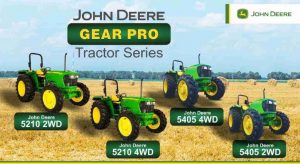– A Comprehensive Guide to Selecting the Right Tractor
As the festive season of Dussehra approaches, farmers across India look forward to investing in essential tools that will enhance their agricultural productivity. Among these, tractors are one of the most important purchases a farmer can make. A well-chosen tractor can greatly improve efficiency, reduce manual labour, and enable the use of various implements to perform tasks ranging from tilling to planting and harvesting. However, with the myriads of options available in the market, selecting the right tractor can seem daunting.
This article endeavours to guide you through the tractor-buying process, offering insights on the types of tractors available, key factors to consider, the role of implements, leasing and renting options, the overall state of the tractor industry in India, and government schemes that make owning a tractor more accessible. Whether you’re looking to upgrade your existing machine or purchase your first tractor, this comprehensive guide will help you make an informed decision this Dussehra.
Overview of the Indian Tractor Industry
The Indian tractor industry has come a long way since the first models were imported into the country in the 1940s. Today, India stands as the world’s largest tractor market in terms of unit sales, with an annual production exceeding 800,000 units. This transformation is primarily driven by the increasing mechanization of Indian agriculture and the government’s push to support the farming community through subsidies, loans, and initiatives aimed at improving agricultural productivity.
The tractor industry in India is dominated by homegrown brands like Mahindra & Mahindra, which holds the largest market share, followed by TAFE (Tractors and Farm Equipment Limited), Sonalika, and Escorts. Global brands like John Deere and Kubota have also established a foothold in the Indian market, offering technologically advanced tractors suited for modern farming needs.
Growth Trends and Market Dynamics
Several factors contribute to the growing demand for tractors in India:
- Rising labour costs: As wages for agricultural labourers increase, farmers are turning to mechanization as a more cost-effective solution.
- Small and marginal farmers: The Indian government has introduced schemes and subsidies to make tractors affordable for small and marginal farmers, leading to a surge in first-time buyers.
- Government initiatives: Programs like the Pradhan Mantri Krishi Sinchayee Yojana (PMKSY) and various state-sponsored schemes offer financial assistance and subsidies for purchasing tractors and implements.
- Innovative models: Manufacturers are increasingly focusing on developing compact and fuel-efficient models, which cater to small farms and orchards.
The growing adoption of smart agriculture technology, such as GPS-guided tractors and telematics, has also paved the way for a new era of precision farming in India.
Understanding Tractor Types and Their Applications
Tractors are essential for performing a wide range of agricultural tasks. However, the type of tractor you choose should depend on the scale of your farming operations, the type of crops you grow, and the specific tasks you need the machine to perform. Let’s take a closer look at the various types of tractors available in India.
1. Utility Tractors
Utility tractors are the workhorses of the farm, designed for general-purpose farming tasks such as ploughing, tilling, mowing, and transporting goods. They typically come with a power output ranging between 30-60 HP and can be equipped with various attachments and implements.
Ideal for: Medium to large-scale farms, versatile operations.
Example Models:
- Mahindra 585 DI Power+ (50 HP)
- TAFE 5450 DI (45 HP)
2. Compact Tractors
Compact tractors are smaller and lighter compared to utility tractors, making them ideal for use in small farms, orchards, and gardens. Despite their size, these tractors are incredibly efficient and can handle light agricultural tasks such as mowing, landscaping, and light tilling.
Ideal for: Small farms, orchards, greenhouses.
Example Models:
- John Deere 3028 EN (28 HP)
- Kubota NeoStar A211N (21 HP)
3. Row Crop Tractors
Row crop tractors are specialized machines designed for planting and cultivating crops in rows. They are built for precision farming and often come equipped with advanced features such as GPS navigation and telematics to help in precise planting, fertilization, and weeding.
Ideal for: Large-scale farming operations with row crops (e.g., sugarcane, cotton, corn).
Example Models:
- Sonalika Sikander RX 60 (60 HP)
- Mahindra Arjun Novo 605 DI-i (57 HP)
4. Heavy-Duty Tractors
For large-scale farms and demanding terrains, heavy-duty tractors with a horsepower range of 70+ HP are essential. These tractors are often used for heavy ploughing, harvesting, and hauling large quantities of produce or materials. They are built to withstand the rigors of intensive farming activities.
Ideal for: Large-scale commercial farms, rugged terrains.
Example Models:
- John Deere 5075 E (75 HP)
- New Holland Excel 9010 (90 HP)
5. Electric Tractors
Electric tractors are the latest innovation in the agricultural industry, designed to offer sustainable and environmentally-friendly solutions to farming. These tractors run on electric power, reducing fuel costs and emissions while still providing adequate power for farming tasks.
Ideal for: Small to medium farms looking for eco-friendly solutions.
Example Models:
- Sonalika Tiger Electric (50 HP)
- Kubota L2501 (25 HP, hybrid)
6. Specialty Tractors
Specialty tractors are designed for specific tasks or unique environments such as vineyards, orchards, or hilly regions. These tractors have unique configurations to navigate narrow rows or steep inclines, ensuring efficiency in niche farming operations.
Ideal for: Vineyards, orchards, or regions with challenging terrain.
Example Models:
- New Holland TD3.50 F (50 HP)
- Swaraj 735 XM Orchard (35 HP)
A comparative analysis of various tractors in India
| Type | Horsepower (HP) | Price Range (INR) | Best Uses | Popular Models |
| Compact Tractors | 15-30 HP | ₹2.50 – ₹6.00 lakh | Small farms, orchards, gardens | John Deere 3028 EN, Kubota NeoStar A211N |
| Utility Tractors | 30-50 HP | ₹4.00 – ₹8.00 lakh | General-purpose farming | Mahindra 585 DI Power+, TAFE 5450 DI |
| Row Crop Tractors | 50-70 HP | ₹6.00 – ₹12.00 lakh | Row crop farming | Sonalika Sikander RX 60, Mahindra Arjun Novo 605 |
| Heavy-Duty Tractors | 70+ HP | ₹12.00 – ₹25.00 lakh | Large farms, heavy tasks, rough terrains | John Deere 5075 E, New Holland Excel 9010 |
| Electric Tractors | 25-50 HP | ₹8.00 – ₹16.00 lakh | Eco-friendly farming, reducing fuel costs | Sonalika Tiger Electric, Kubota L2501 |
| Specialty Tractors | 30-50 HP | ₹3.00 – ₹7.00 lakh | Vineyards, orchards, challenging terrain | New Holland TD3.50 F, Swaraj 735 XM Orchard |
The Role of Implements in Maximizing Tractor Efficiency
One of the most significant advantages of owning a tractor is its compatibility with various implements that enhance productivity. A tractor on its own can perform a limited number of tasks, but when paired with the right implements, it becomes a powerful tool capable of managing multiple agricultural operations with ease. Some of the most commonly used implements include:
1. Ploughs
Ploughing is one of the first steps in preparing land for planting, and a good plough helps break up the soil, improving aeration and nutrient mixing. There are different types of plough such as mouldboard ploughs, chisel ploughs, and disc ploughs, each suited for different soil types and farming needs.
2. Seeders and Planters
These implements automate the process of planting seeds at the correct depth and spacing, saving time and ensuring uniform crop growth. Seeders are typically used for small-scale operations, while planters are more suited for large farms.
3. Mowers and Balers
For farms that produce hay or fodder, mowers and balers are indispensable tools. Mowers help in cutting the grass or hay, while balers pack the cut material into compact, manageable bales.
4. Sprayers
Pesticide and herbicide sprayers can be mounted on tractors to automate the process of protecting crops from pests and diseases, reducing labour and ensuring even application.
5. Loaders and Backhoes
For tasks like digging, hauling, or lifting heavy materials, front-end loaders and backhoes are essential tractor attachments. They’re particularly useful on farms with construction or landscaping needs.
By investing in the right combination of implements, farmers can significantly improve the efficiency of their operations, reducing labour and time while increasing productivity.
Should You Lease, Rent, or Buy a Tractor?
A) Leasing a Tractor
Leasing allows farmers to use a tractor for a specific period (typically 3-5 years) without committing to an outright purchase. This option provides flexibility, especially for small farmers who may not have the capital for a full purchase. At the end of the lease period, you may have the option to buy the tractor at a reduced price, trade it in for a newer model, or simply return it.
Benefits of Leasing:
- Lower upfront costs.
- Access to the latest models and technology.
- Option to upgrade or return the tractor at the end of the lease term.
B) Renting a Tractor
If you need a tractor for short-term use or specific seasonal tasks, renting may be a more affordable option. Renting allows you to pay for the tractor on a daily, weekly, or monthly basis, and you can choose from a wide range of models depending on the task at hand. This option is particularly useful for farmers who don’t require a tractor year-round.
Benefits of Renting:
- Flexibility to rent specific models for specific tasks.
- No long-term commitment or maintenance costs.
- Ideal for small farmers or those with occasional tractor needs.
C) Buying a Tractor
If you plan to use a tractor extensively throughout the year, purchasing one is likely the most cost-effective option in the long run. While the initial investment is higher, owning a tractor allows you to customize it, add attachments, and use it without worrying about leasing or rental agreements.
Benefits of Buying:
- Full ownership and customization.
- Long-term cost savings.
- Higher resale value.
Government Schemes, Subsidies, and Loans for Tractor Buyers
One of the primary concerns for prospective tractor buyers is the cost. Fortunately, the Indian government offers several financial assistance programs to make tractors more affordable, especially for small and marginal farmers. Here’s a closer look at some of the most prominent schemes:
1. Pradhan Mantri Kisan Tractor Yojana (PM Kisan Tractor Scheme)
This scheme is designed to help small and marginal farmers purchase tractors at subsidized rates. Eligible farmers can receive a 20-25% subsidy on the purchase of a new tractor, making it easier to access modern agricultural machinery. This scheme is available to farmers across India and is part of the government’s efforts to promote mechanization and boost productivity.
2. NABARD Agricultural Loans
The National Bank for Agriculture and Rural Development (NABARD) offers low-interest loans for farmers looking to purchase tractors, implements, and other agricultural machinery. These loans typically cover up to 85% of the tractor’s cost, with repayment terms extending up to 7 years. NABARD’s agricultural loans are available through various partner banks across India, and farmers can apply by visiting their local bank branch.
3. State-Level Subsidies
In addition to national schemes, many state governments offer their own subsidies for tractor purchases. For example, states like Punjab, Haryana, and Uttar Pradesh provide additional financial assistance for farmers purchasing tractors. These subsidies often range from 25-50%, depending on the type of tractor and the farmer’s eligibility.
For more information on these schemes, visit the NABARD official website or consult your local agricultural office.
KhetiGaadi: Empowering Farmers with the Right Tractor Choices
In the fast-evolving world of agriculture, access to the right information and resources is crucial for making informed decisions. KhetiGaadi, a leading online platform, has emerged as a game-changer for farmers in India. Whether you’re looking to buy, sell, rent, or lease a tractor, KhetiGaadi offers a one-stop solution for all your tractor-related needs.
Services Provided by KhetiGaadi
- Tractor Comparison Tool: With KhetiGaadi, you can compare different tractor models based on features like horsepower, fuel efficiency, pricing, and more. This tool helps farmers make a well-informed decision tailored to their specific needs.
- Expert Consultation: Not sure which tractor to buy? KhetiGaadi connects you with agricultural experts who provide personalized advice based on your farming requirements, soil type, and crop patterns.
- Financial Support: Through partnerships with leading financial institutions, KhetiGaadi assists farmers in securing easy loans, EMIs, and leasing options for tractor purchases.
- Tractor Rental and Leasing: If you’re not ready to commit to a full purchase, KhetiGaadi offers a platform where you can rent or lease tractors at affordable rates. This service is especially beneficial for small and marginal farmers who may not have the capital to buy a tractor outright.
- Buy and Sell Platform: Looking to upgrade your tractor or sell an old model? KhetiGaadi’s marketplace connects buyers and sellers, making the process quick and hassle-free.
KhetiGaadi has revolutionized how farmers access information, making the process of buying, selling, and renting tractors transparent and convenient. For more information, visit KhetiGaadi’s official website.
Conclusion: Choosing the Right Tractor for Your Farm
As we celebrate Dussehra, many farmers will look to make important investments in their agricultural operations. A tractor is not just a tool; it’s an investment in your farm’s future. By considering factors such as horsepower, tractor type, implements, and financing options, you can make an informed decision that will enhance your productivity and profitability.
This guide has provided a detailed overview of the different types of tractors available in India, the role of implements, leasing vs. buying options, government schemes, and the invaluable support offered by platforms like KhetiGaadi. Whether you choose to buy, lease, or rent a tractor, remember that the right tractor can make all the difference in your farming operations.
Happy Dussehra, and Happy Farming!!
Relevant Links:
Department of Agriculture and Farmers Welfare
Tags:




